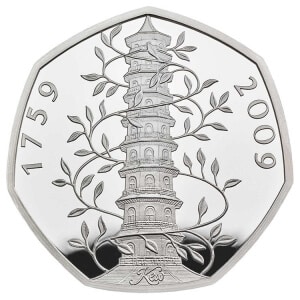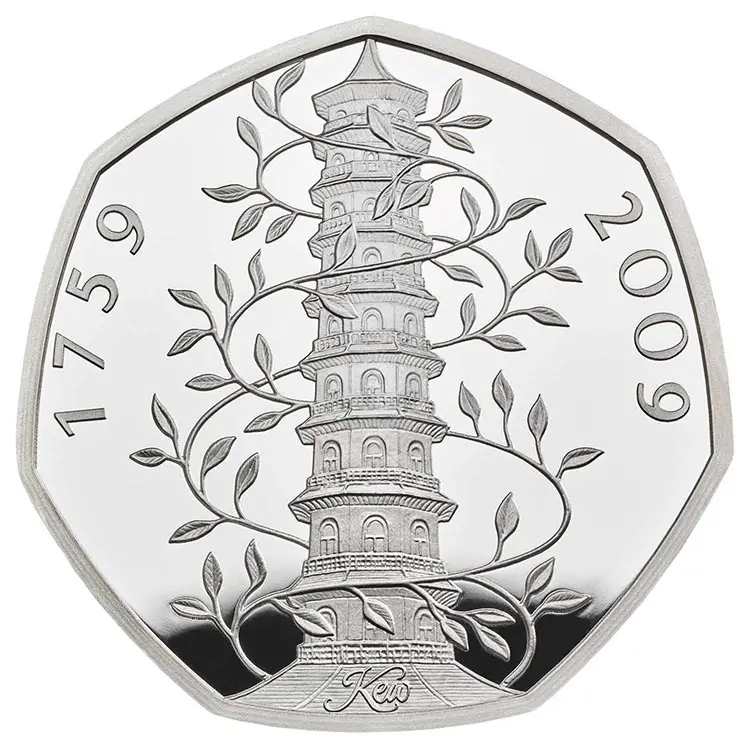The Kew Gardens 50p is one of the rarest 50p coins out there, but how much is it worth today?
According to average selling prices on eBay in 2022, you can expect to pay around £148 for a Kew Gardens 50p.
Although this varies greatly with the condition, there’s no denying that the Kew Gardens 50p is worth a lot to collectors. Coins like these are one of the many reasons why it’s always worth checking your change every now and then – you never know what treasure might be hiding!
How many Kew Gardens 50p coins were made?
The 2009 Kew Gardens 50p coin is the second rarest 50p coin produced by the Royal Mint. With an official mintage figure of 210,000, it is second only to the 1992 Single Market Presidency 50p, of which only 109,000 were ever produced.
However, given that larger format 50p coins were withdrawn from circulation in 1997, the Kew Gardens coin is the rarest 50p coin in circulation today, despite its higher production count.
The coin is not only rare in terms of mintage but scarce in terms of availability. Due to its very limited mintage, the Kew Gardens 50p does not often appear for sale and is recognised as one of the hardest 50p coins to get a hold of.
To put the coin’s rarity into context, there were approximately half a billion of the 2007 Brittania 50p put into circulation, featuring the last Raphael Maklouf portrait of the Queen. The next special edition coin minted after the Kew Gardens 50p was the Girl Guiding 50p – of which 7.4 million were made.
After this, the Royal Mint went on a run of low mintage coins, with the 2011 commemorative Olympics set of 29, however, none of them came close to matching the Kew Gardens 50p for rarity, with the rarest having a mintage of 1,125,500.
Although the coin underwent a limited production run when it was first minted in 2009, it was re-issued in 2019 as part of the celebrations for the fiftieth anniversary of the 50p coin. This later mintage did not, however, enter the general circulation and remains a commemorative issue purchasable from the Royal Mint and various collectors. The design of this later issue is precisely the same as its 2009 version
The Kew Gardens 50p also stands out due to the number of counterfeits produced, given the original coin’s high value. On these, the eye of the Queen on the obverse is usually displayed incorrectly, and the coin is far lighter in colour than what it should be, presumably owing to deficiencies in the alloy.
The design of the Kew Gardens 50p coin

The obverse side of the coin features a portrait of the Queen by Ian Rank-Broadley. This portrait was used on all UK coinage from 1998 to 2014 and for some 2015 coins. It was the fourth portrait of the Queen used on British coinage, succeeding the work of Raphael Maklouf on those before it.
The reverse of the coin, designed by the British painter and former President of the Royal Academy of Arts, Christopher LeBrun, features the famous Chinese Pagoda at Kew Gardens. The Pagoda was designed by Sir William Chambers, the Scottish-Swedish architect who had spent many years travelling in Asia.
It was given as a gift to Princess Augusta, widow of Frederick, Prince of Wales (son and heir of King George II) and the founder of Kew Gardens. On the coin, laurel leaves wind their way around the tower, a classical Georgian folly that offered one of the best views of London at the time, with the word ‘Kew’ written in cursive script at the bottom of the structure.
The reverse of the coin omits the denomination, which is instead on the obverse side, below the portrait of the Queen. The Kew Gardens 50p is one of the few coins not to display the denomination on the reverse until this practice became more widespread with the Beatrix Potter series beginning in 2016.
Why was it made and what does it commemorate?
The coin was minted to commemorate the 250th anniversary of the Royal Botanic Gardens at Kew, near Richmond in South West London, one of the UK’s most beloved cultural attractions.
The site has been a seat for nobility in London since circa 1299 when Edward I relocated his court to a large manor house in Richmond. Henry VIII’s father, Henry VII (formerly Henry Tudor), continued the royal tradition at Kew by building Sheen Palace (later renamed Richmon Palace) in 1501. Subsequent monarchs and nobles improved the area known as Kew Field, which in 1600 was still largely pastoral and farmland.
In the mid-1700s, Lord Henry of Tewkesbury spent vast sums building an exotic garden at Kew Park. In 1771, what we now know as Kew Gardens was constructed on and around this site by Princess Augusta.
The gardens were given a national botanic status in 1840 and soon after were extended to its present size of 300 acres.
Kew has seen its fair share of social upheaval and distress. Suffragettes Olive Wharry and Lilian Lenton burned down the famous Tea House in their quest for the vote. Kew emerged relatively unscathed during the Blitz, and the Chinese Pagoda featured on the coin was even used to test the aerodynamics of prototype bombs that would eventually fall on Berlin.
The area suffered large amounts of damage during the Great Storm of 1987 and hundreds of trees and foliage were lost to the elements.
Kew’s finest hour came in 2003 when it was placed on UNESCO’s list of World Heritage Sites, of which there are only 1,121 around the world. This status reinvigorated public interest in the Gardens, which were given a £40 million revamp in 2018, with most of the money going towards the renovation of Temperate House.
Only 5 trees survive from the establishment of the gardens in the 1760s. These are known nationally as the ‘Five Lions’:
- Ginkgo (Ginkgo biloba)
- Scholar tree (Styphnolobium japonicum)
- Oriental plane (Platanus orientalis)
- False acacia (Robinia pseudoacacia)
- Zelkova (Zelkova carpinifolia)
Where can you buy the coin?
eBay is one of the best places to buy a Kew Gardens 50p simply due to the supply of them that are available; although you’ll need to watch out for fake versions.
Aside from eBay, you’ll have to look privately to pick up an example as the coin is so scarce these days – even the Royal Mint doesn’t sell examples of the coin. They do however sell a 2019 version as part of the 50 years of the 50p collection.
The 2019 Kew Gardens 50p Coin
If you decide to pick up a 50 Years of the 50p proof coin set from the Royal Mint, you’ll find that there is a specially made 2019 Kew Gardens 50p in the collection.
This was added as recognition of the coin and the impact that it has had on the coin collecting culture within the UK. In this set, the coin has a diameter of 27.30mm and is made from 0.925g Sterling Silver.
